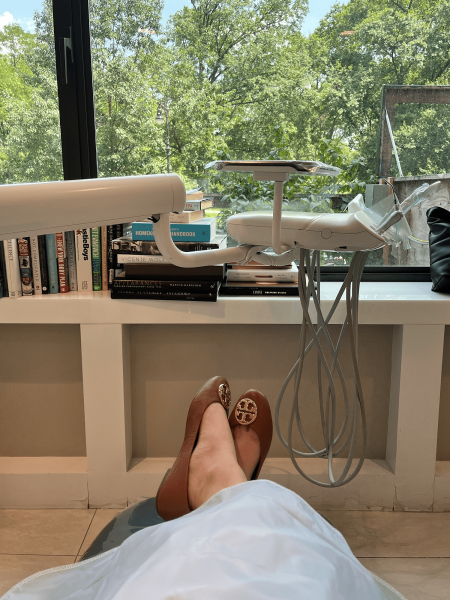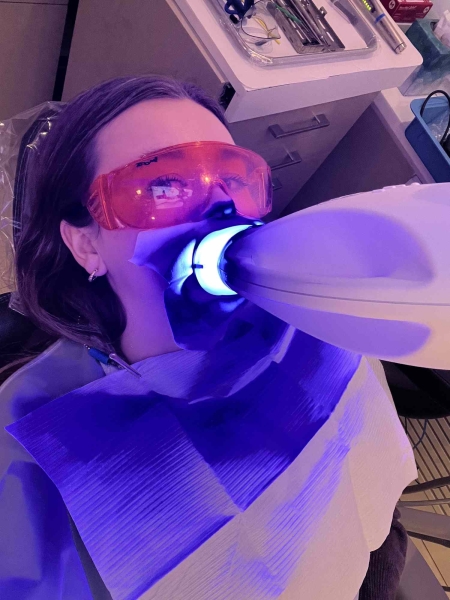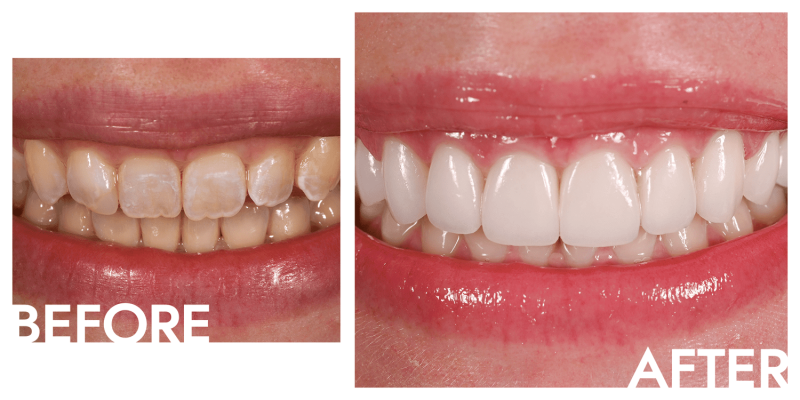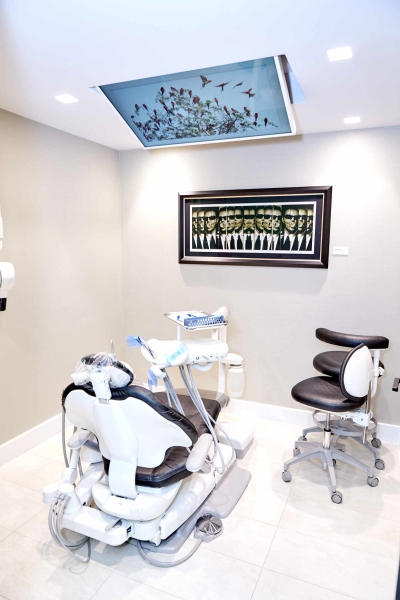
My Results Choosing a Dentist The Takeaway
The beauty industry has come a long way in terms of openly (and shamelessly) discussing treatments like Botox, lip fillers, and body sculpting. In the last decade, the conversation around professional—and oftentimes expensive—beauty enhancements has been far more transparent, with those who have received cosmetic treatments being more open about the process, cost, and results to empower those who are considering a similar financial investment. But there’s still one category of treatment that’s discussed less openly: smile enhancements.
In middle school, a slippery diving board left me with a fairly traumatic facial injury. I tore my lip, fractured my nose, and—most noticeably—cracked my front five teeth. Even after filling in the largest gaps with a composite material, the accident still left me with teeth that were small, jagged, and stained. As I continued to grow and mature into my 20s, my teeth didn't follow suit. The further I grew into adulthood, the smaller and more juvenile my smile felt. I found myself not only hesitating to smile in public, but actually feeling a genuine sense of unhappiness. (Imagine that every time something made you want to laugh or smile, a tiny voice inside your head told you that you shouldn't.)
The sentiment led me down a research rabbit hole where I discovered dozens of little-talked-about treatments (and an entire field of dentistry) dedicated to improving the appearance of your smile. So a little over a year ago, I embarked on a journey to achieve a more confident, uninhibited smile. For me, that meant a combination of cosmetic dental treatments (and a little bit of therapy, TBH). So ahead, I'm breaking down every single treatment I received as part of my smile makeover with pro tips from the dentist responsible for my transformation, Dr. Marc Lowenberg.
Gum Contouring
One of my biggest complaints about my natural teeth is their size. My teeth were already small by "adult" standards, and the chipping and cracking from my accident certainly didn't help. So to create more surface area, Dr. Lowenberg insisted I'd need a gum contouring procedure. Also referred to as "crown lengthening" or a "gum lift," gum contouring raises the gum line to allow for more of your teeth to show when you smile (and less of your gums). "Some people have what we call a 'gummy smile,' which means when they smile, they show a lot of gums," says Dr. Lowenberg. "In some cases, when you place veneers, it makes the gummy smile more obvious because the teeth are now whiter. In these cases, we recommend a 'gum lift,' which raises the gum so that more tooth is showing. This is especially important when the patient has small teeth to begin with. Raising the gum allows us to make a veneer that makes each tooth appear bigger. Each case is different, and that is why your dentist must not only be great technically but also have a great eye for aesthetics." Fortunately, Dr. Lowenberg adds that a "very small" percentage of his veneers patients require gum contouring. And even more fortunately, I can assure you that if you do need this procedure, it's completely painless and recovery is a breeze if you follow the instructions from your provider.
Pain, Recovery, and Aftercare
Throughout my smile journey, this was the procedure I was most nervous about in terms of pain, but it was actually the most comfortable stage of the entire process. The procedure will be performed by a periodontist, who will numb you completely throughout the procedure. (You won't feel a thing, I promise.) I was also prescribed a painkiller to take for the first few days of recovery, but found that I was so comfortable I didn't even fill the prescription.
In terms of recovery, the worst part is having to eat a limited diet. You'll only be able to eat soft foods for the first few days, and won't be able to bite into any food for the first two weeks while your stitches heal (they dissolve automatically, so you won't have to go back in to have them removed). Instead, everything will need to be cut into small bites and chewed with your back teeth. Other than that, you'll brush as normal, rinse with a saltwater and hydrogen peroxide cocktail, and enjoy the immediate appearance of larger, more brilliant teeth.
Cost
If gum contouring isn't covered by your insurance, the cost will vary drastically based on how many teeth need to be treated. You can expect a range of $2,500 – $8,000.

Veneers
In terms of a dramatic before and after result, veneers are what will give you that money shot. “Veneers are porcelain facades that are hand-crafted and bonded to your teeth on the outside of the tooth,” says Dr. Lowenberg. “Veneers can correct dark or stained teeth, crooked teeth, short teeth, a narrow arch, an aging smile, and if done correctly can transform any smile into a beautiful one.” Dr. Lowenberg—who specializes in extremely natural-looking veneers—also notes that many of his patients remark that their complexions feel brighter and younger overall after getting veneers. Dr. Lowenberg and I decided on 10 upper veneers to address my most significant concerns about my smile while minimizing the cost of replacing them later on (fewer veneers now means fewer I have to replace when the first set wears out).
If you don't require any preliminary dental work (such as gum contouring), then veneers are typically completed within three dental visits spaced about two weeks apart: a consultation, a "temporary" installation for you to "try on" your smile, and the permanent installation. "The focus of the [temporaries] is to make room for the laminates in your mouth, so the tooth structure is slightly reduced by less than one millimeter," says Dr. Lowenberg. It's important to note that you may have seen frightening photos of people with their natural teeth drilled to "shark teeth" before veneers insertion. In actuality, an experienced, qualified cosmetic dentist will be able to insert your veneers without removing significant tooth structure (I took a picture of my "prepared" teeth and couldn't tell that they'd been touched at all).
"After preparation of the teeth, an impression is taken of your prepared teeth and sent to the ceramist," Dr. Lowenberg continues. "You leave the office with temporary veneers, which is already a visual improvement from the original teeth. If you want to make changes, the dentist can make slight changes. You can reshape the temporaries until the patient loves what they see. Then the ceramist replicates the smile design and fabricates the porcelain facades. At the [next] visit, the temporaries are removed and the customized porcelain veneers are bonded or glued onto the teeth, completing the transformation of your smile. Once the procedure is completed, we have the patient come back a week later to adjust the bite or occlusion of the new teeth."
Pain, Recovery, and Aftercare
Once again, I'm thrilled to report that the veneers process is completely painless—although veneers may be more bothersome than gum contouring if you become anxious around the sound of dental tools. For both the temporary and the permanent veneers, you'll be put under local anesthesia, so you won't experience any pain throughout the treatments. Optionally, you can also ask for laughing gas to help you calm down (which I chose to do for the temporaries, but opted out of for the permanent veneers once I knew it was truly painless). I went back to work right after both procedures and was able to function normally.
Once you're at home and recovering from the temporaries, the aftercare is similar to that of gum contouring. You'll be rinsing with a mix of salt water and hydrogen peroxide twice a day, and will need to avoid biting into anything (like sandwiches, apples, and pizza) for the full two weeks while you wear the temporaries. Since they are meant to be fairly easily removed by your dentist once you come in for the permanent smile, they can become dislodged with biting and pulling motions. But once your permanent smile is in, you'll be able to return to eating normally. If you take care of your new smile—brushing, flossing, regular dental cleanings and wearing a night guard if you grind your teeth—Dr. Lowenberg says that your veneers can last about 20 years or more. "It’s not that they fall off teeth, but they age just like everything else does," he says. "It’s not going to look as white and fresh as the day you put them in."
Cost
Cost will vary drastically based on the number of veneers you need and where you live. In New York City for example, Dr. Lowenberg says you can expect to pay about $3,000–$4,500 per tooth. Whereas in less metropolitan areas of the country, the price range can be closer to $1000-$2000 per tooth. As this is a cosmetic procedure, most veneers patients will need to pay for their new smile out of pocket. But if you and your doctor can make a case to your insurance provider that veneers are needed to preserve the structure and/or functionality of your teeth, it's possible to have most (or part) of the procedure covered.
Power Teeth Whitening
Because I opted for 10 upper veneers and left the bottom teeth untouched, Dr. Lowenberg suggested a treatment called “power teeth whitening” to get my bottom teeth closer to the bright, natural white of my new veneers. “The fastest way to whiten teeth is through in-office power whitening—we use the in-office whitening system, Zoom!, [which] uses a 35% hydrogen peroxide treatment, then the patient sits under a high-intensity light,” he says. “The light activates the bleach to speed up its penetration through the enamel, effectively whitening teeth in just one hour. Zoom! uses a power light instead of a laser, so there is less sensitivity since today’s power lights do not heat up the teeth as much and are more effective in bleaching the teeth.”

Pain, Recovery, and Aftercare
While you would think teeth whitening would be the most comfortable of the procedures listed here, I found it to be the most uncomfortable step in my journey. During the procedure, you may feel quick bursts of sensitivity ringing through your teeth every few minutes. And unfortunately, it isn't uncommon for this sensation to continue for a few hours (getting farther and farther apart as the day goes on) after your treatment. I was still able to return to work after the procedure and function normally, but definitely experienced what I would describe as discomfort.
That being said, some people don't experience any pain at all, and find that the worst part is having to consume a bland diet for the days following the procedure. Your dentist will advise you to avoid colorful foods (including coffee) for 3-5 days and stick to foods like rice, chicken, potatoes, and fish. As a general rule of thumb, Dr. Lowenberg advised me that anything that could stain a white t-shirt could stain your teeth (and should thus be avoided for those first few days).
My Results

As you can see, my results are dramatic and speak for themselves. My teeth are simultaneously brighter, whiter, straighter, and larger, and have brought overall brightness and harmony to my entire face. The first moment I looked in the mirror and saw my new smile, I burst into tears of joy.
And while the veneers were definitely the MVP of my smile journey, I love how the combination of treatments produced a gorgeous, natural, conservative result that maintained as much of my natural tooth structure as possible. The results are so natural and so tailored to my unique face structure that the first day I returned to the office, my co-workers knew I'd had something done but couldn't quite pinpoint what it was (the most popular question of the day was, "Did you get a facial or something?").
The results also go far beyond the drastic, cosmetic improvement. After making the decision to enhance my smile for me, I am smiling so much more. I find myself flashing full-toothed smiles at strangers, letting out wide-mouthed laughter, and feeling far more confident in my day-to-day life. That joy was always within me, but having a smile to reflect it has helped bring it out.
Choosing a Dentist
Choosing a qualified provider is the most important step in any smile journey. While general dentistry practices may offer veneers, it's crucial to visit a cosmetic dentist who can marry the tactical skills of the health and function of your teeth with a trained eye for aesthetics. Crafting a new smile with a health-forward approach to the teeth is a true art form, and one that should be exercised by experienced hands. If you're in New York City, I cannot recommend Dr. Lowenberg enough. His results speak for themselves, but he also made me feel extremely comfortable and unrushed during the entire process. He explained every detail in terms I could understand, didn't rush my questions, and seemed to genuinely take immense joy and pride in delivering on my wildest smile dreams.
Aside from choosing a skilled dental provider, it's also important to be knowledgeable about the ceramist (and lab) that will actually craft your veneers. Most practices will outsource this step of the process, which can lead to longer wait times for the installation. Fortunately for me, Dr. Lowenberg's office has an in-house ceramics lab led by legendary veneers ceramist Jason Kim (he's basically the Beyoncé of crafting veneers, and is known for his life-like, long-lasting artistry). "The artistry is what makes your teeth look much more life-like and natural," says Dr. Lowenberg. "Artistic talent plays a great part in creating beautiful smiles and that is what makes us great at what we do. It is not just the technical aspect of dentistry but also our artistic eye. That’s why we call our practice 'The Art of the Smile'—it is art!"

Finally, you'll want to consider the overall space that your dentist operates in. Since you'll be having multiple appointments (with some appointments being a few hours long), you want to make sure your provider's practice offers a comfortable and calming experience. LLK for example has treatment rooms with sweeping views of Central Park, as well as televisions on the ceiling (equipped with most streaming services) to help you relax during your treatment. The office also practically doubles as an art museum, with a chic spiral staircase and iconic black-and-white photographs that make me feel like I'm at an exclusive gallery preview instead of a dentist's office.
The Takeaway
After receiving multiple treatments over the course of the year, I can definitely say that a smile makeover is a significant investment of time and money. But what I can say even more definitively is that I would do it all over again. My smile has brought me immeasurable joy and confidence, and I feel that my physical smile finally reflects my inner joy. When considering a smile makeover, it's important to visit a provider who specializes in cosmetic dentistry (and preferably one who has decades of experience doing so). Don't be tempted by cost-saving measures (such as traveling abroad) when it comes to your teeth. Cosmetic dentistry is an art form that comes at a cost, and it's a cost that's well worth it for natural results that are as stunning as they are functional.

